 Image search results - "nishino" Image search results - "nishino" |

Nishino Water Tunnel is near Lake Biwa at the foot of the Yamamoto-yama mountains. There are three tunnels. The original one was built in 1845 by a local priest to alleviate frequent flooding. 西野水道 MAP
|
|

Near the tunnel entrance is a rest house where you can borrow rubber boots and flash lights for free.
|
|

Near the tunnel entrance is the Nishino Horinuki Park with various monuments. 西野ほりぬき公園
|
|

Statue and monument at Nishino Water Tunnel entrance.
|
|

Tunnel monument and song monument.
|
|

The monument shows tunnel laborers.
|
|

Monument for a song about the tunnel digging, titled "Nishino Suido Uta."
|
|

Lyrics to the song, "Nishino Suido Uta." 西野水道歌
|
|

This is the original Nishino Water Tunnel built in 1845. Engineered by a Buddhist priest named Esho and with the help of fellow villagers, it took 6 years to dig through the mountain for about 220 meters. The tunnel drained excess water to Lake Biwa.
|
|

You can enter and go through the Nishino Water Tunnel. Water does not flow through anymore, but it's still quite muddy and wet.
|
|

The problem is, it's pitch black on the inside, and the tunnel size is quite small and craggy. Hard hats required. Not recommended, especially if you are taller than a 10-year-old.
|
|

This is the other end of the original tunnel. The air was cold on this end.
|
|

This is the second water tunnel, next to the original tunnel and running parallel.
|
|

Entrance to the second water tunnel. This is much larger, large enough for a car to pass through. No longer used as a water drainage tunnel. We could easily walk through this tunnel.
|
|

Floor of second water tunnel. Some water still flows through. Boots recommended.
|
|

Other end of the second tunnel. This tunnel is no longer used for Yogo River. It is now mainly used by people wanting to go fishing.
|
|

This is the third water tunnel and currently in use. The Yogo River flows out of it to Lake Biwa. Built in 1980. Also a local fishing spot.
|
|

Yogo River mouth outside the Nishino water tunnel. Lake Biwa ahead.
|
|

Original Nishino Water Tunnel facing Lake Biwa.
|
|

Barrels of sake displayed for Toka Ebisu inside Hanshin Nishinomiya Station.
|
|
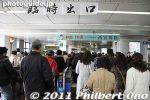
Exiting Hanshin Nishinomiya Station on Jan 10, 2011.
|
|

Ebessan-suji road going to Nishinomiya Jinja Shrine.
|
|
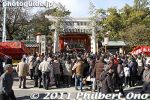
Entering Nishinomiya Shrine at the Omote Daimon Gate, usually called Akamon Gate. 西宮神社表大門 通称赤門
|
|
|
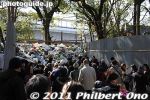
Along the way, there was a place where you could throw away your old Ebisu decorations.
|
|
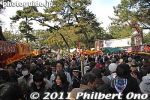
People on the left are leaving the shrine, while people on the right are heading for the shrine. About a million people visit Nishinomiya Shrine during Jan. 9-11.
|
|
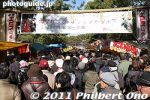
It's a stop-and-go process.
|
|
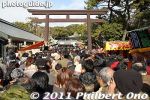
But we got nearer and nearer so it wasn't so bad and it wasn't taking forever.
|
|
|
|
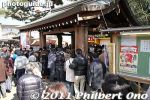
Wash basin to purify yourself. Few people stopped here.
|
|
|
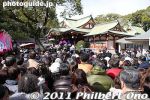
Haiden hall up ahead. Behind it is the Honden main hall.
|
|
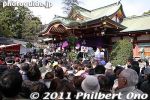
Nishinomiya Shrine worships a god named Hiruko (蛭子), also known as Ebisu, one of the Seven Gods of Fortune. Ebisu is regarded as the god of fishermen and good fortune depicted as a rotund, bald man holding a tai sea bream.
|
|
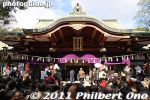
Nishinomiya Shrine's Haiden Hall. It took about 30 min. to get here from Akamon Gate.
|
|

On the left was a separate entrance here to see the giant tuna (maguro).
|
|

Entering the Nishinomiya Shrine's Haiden Hall.
|
|
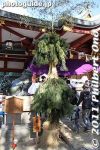
Something unique is this upside down kadomatsu decoration flanking Nishinomiya Shrine's Haiden Hall.
|
|

About the upside down kadomatsu.
|
|
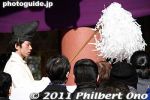
They also waved sacred staffs over our heads as we entered the Haiden.
|
|
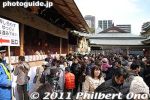
After passing through the Haiden, there's the Honden main worship hall, the shrine's main building.
|
|
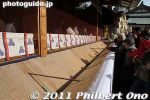
The Honden had this narrow but long offertory box. Surprisingly small for a huge occasion as this.
|
|
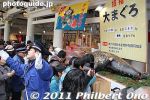
They also had a giant maguro tuna fish on display as an offering to the shrine from a fishing cooperative.
|
|
|
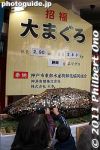
The tuna is 2.9 meters long weighing 280 kg. About the same as two sumo wrestlers.
|
|
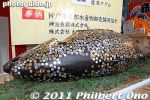
The tradition is to stick on coins on the tuna.
|
|
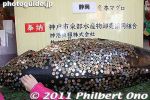
By this time, the tuna was dry and solid as a rock. It was impossible to stick on more coins.
|
|
|
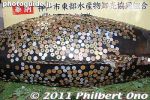
Coins stuck on giant tune at Nishinomiya Shrine Toka Ebisu.
|
|
|
|

They stuffed coins in every crack and crevice of the fish. I wonder who's gonna eat the fish afterward.
|
|
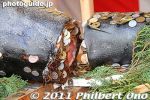
Where the tail is cut off.
|
|
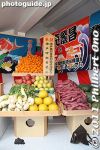
Fruits and vegetable offerings from the local produce cooperative.
|
|
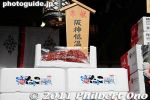
Offering of octopus (tako).
|
|
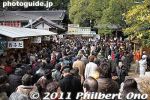
Scene after you exit the Honden.
|
|
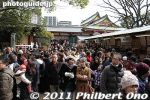
Exiting the Honden.
|
|
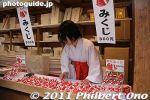
Selling omikuji fortunes.
|
|

Nishinomiya Shrine's 300-yen omikuji comes with a cute tai (sea bream).
|
|
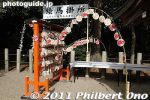
Ema tablets.
|
|
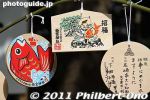
Ema tablets at Nishinomiya Shrine.
|
|
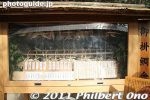
Tai sea bream display case.
|
|
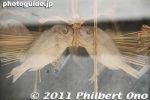
Tai sea bream pair.
|
|

About the tai sea bream.
|
|
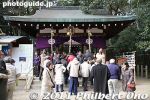
Smaller shrines in Nishinomiya Shrine.
|
|
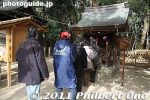
Homusubi Shrine
|
|

About Homusubi Shrine.
|
|
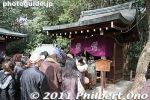
Hyakudayu Shrine
|
|

About Hyakudayu Shrine.
|
|
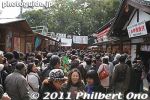
Proceed further to see more vendors.
|
|
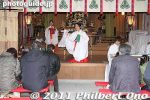
Sacred dancer.
|
|
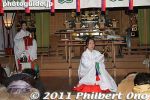
Pay a fee to enter this little hall to be blessed with a sacred dance.
|
|
|
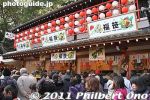
Fuku-zasa tree branches for prosperity and good fortune sold here.
|
|
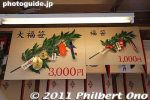
Fuku-zasa branches cost 1000 or 3000 yen.
|
|
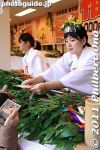
Nishinomiya Shrine maiden selling Fuku-zasa tree branches for Toka Ebisu. I was disappointed that the branches were plastic and all the decorations were already on them.
|
|

At Osaka's Imamiya Shrine (another big Ebisu shrine), the tree branches are real and you can choose which decorations to put on it.
|
|
|
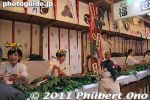
Compared to Imamiya Shrine, they weren't so busy selling fuku-zasa branches.
|
|
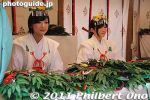
Shrine maidens selling fuku-sasa branches at Nishinomiya Shrine's Toka Ebisu.
|
|
|
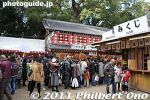
Here's the cheap 100-yen omikuji line, much longer than the one for the 300-yen omikuji.
|
|
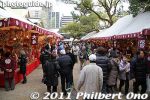
The shrine also had numerous stalls selling Ebisu decorations.
|
|
|

Ebisu decorations
|
|
|
|
|
|

Video of Toka Ebisu at Nishinomiya Shrine, Hyogo.
|
|
|
|
|
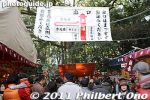
Way home
|
|
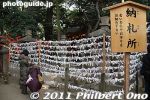
Omikuji
|
|

Shinmei Shrine
|
|

Leaving the shrine was on a narrow, long path.
|
|
|
|
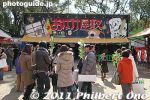
House of Horros amusement even.
|
|

People on the left are heading for the shrine, while people on the right are leaving.
|
|
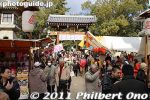
Exiting Nishinomiya Shrine.
|
|

Very narrow path back to the station.
|
|
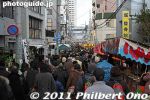
Way to Hanshin Nishinomiya Station.
|
|

Hanshin Nishinomiya Station.
|
|
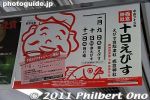
Toka Ebisu ad inside Hanshin Line train.
|
|
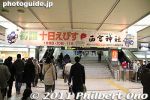
Toka Ebisu banner inside Umeda Station.
|
|
|
|
|